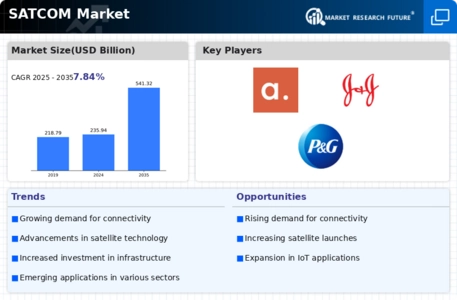Market Share
US SATCOM Market Share Analysis
The US SATCOM market, characterized by its robust demand for satellite communication services, is influenced by various market share positioning strategies employed by key players to gain a competitive edge. One prevalent strategy involves focusing on technological innovation and offering cutting-edge satellite communication solutions. Companies invest heavily in research and development to develop advanced satellite systems, ground infrastructure, and communication terminals that offer superior performance, reliability, and efficiency. By introducing innovative products and services, such as high-throughput satellites, flexible frequency bands, and secure communication solutions, companies can differentiate themselves in the market and attract customers seeking state-of-the-art SATCOM capabilities.
Moreover, strategic partnerships and collaborations are integral to market share positioning strategies in the US SATCOM market. Companies often form alliances with satellite operators, equipment manufacturers, government agencies, and other stakeholders to expand their market reach, access new technologies, and enhance their service offerings. By leveraging complementary strengths and resources, companies can strengthen their market position, broaden their customer base, and pursue opportunities in emerging market segments. Strategic partnerships also enable companies to address evolving customer needs and requirements more effectively, fostering innovation and driving market growth.
Furthermore, market segmentation and targeted marketing strategies play a crucial role in market share positioning in the US SATCOM market. Companies analyze market trends, customer preferences, and industry dynamics to identify specific market segments with distinct needs and preferences. By tailoring their products, services, and marketing efforts to address the unique requirements of each segment, companies can enhance their competitiveness and capture a larger share of the market. For example, companies may develop specialized SATCOM solutions for government, defense, maritime, aviation, enterprise, and consumer markets, each tailored to meet the specific communication needs and operational requirements of these sectors.
Additionally, customer-centric approaches and focus on service quality are essential components of market share positioning strategies in the US SATCOM market. Companies prioritize customer satisfaction by providing reliable, secure, and high-quality communication services backed by responsive customer support and technical assistance. By delivering superior service experiences and building strong customer relationships, companies can increase customer loyalty, retention, and advocacy, thereby solidifying their market position and gaining a competitive advantage. Moreover, companies invest in continuous improvement initiatives, network optimization, and service enhancements to address evolving customer expectations and maintain service excellence in a dynamic and competitive market landscape.
Furthermore, pricing strategies and competitive pricing play a significant role in market share positioning in the US SATCOM market. Companies carefully analyze market dynamics, competitor pricing, cost structures, and customer value perceptions to develop pricing strategies that balance profitability with competitiveness. By offering competitive pricing packages, promotional offers, and value-added services, companies can attract price-sensitive customers and gain market share. Additionally, companies may adopt dynamic pricing strategies, tiered pricing models, and bundled service plans to cater to diverse customer segments and maximize revenue opportunities in the market.






Leave a Comment